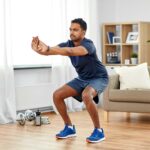
Revitalize Your Neck: Exercises for Well-being
Neck health is vital for a happy life. Our necks hold up our heads and let us look around. But, they can hurt from bad posture or overuse. Neck exercises can make a big difference. They make our necks stronger and more flexible. This means less pain and fewer neck problems later. These exercises are easy and can fit into our daily routines. Doing them often can make our necks feel better and work better. It’s a simple way to take care of our necks and improve our overall health.

Understanding Neck Anatomy
The neck is a key part of our body. It has bones called vertebrae, which stack up to form the spine in our neck. Between these bones are discs that cushion and allow movement. Muscles and ligaments around them help our heads move and stay in place. Nerves run through the neck to our brains and the rest of our bodies.
The neck’s job is big, but it can get hurt easily. Why? Because it moves a lot and holds up our heads. Bad posture, too much screen time, or sudden moves can strain it.
Doing neck exercises helps a lot. They make the muscles stronger and more flexible. This support keeps the neck safe and can fix minor pains. It’s like giving your neck a protective shield, making it less likely to get hurt. Regular exercises are a simple way to keep your neck healthy and strong.
Preparing for Neck Exercises
Before starting neck exercises, it’s crucial to prepare properly. Firstly, start with a gentle warm-up. This can be as simple as walking in place or doing shoulder rolls. These actions get blood flowing to the muscles, making them ready for exercise.
Next, always remember to stretch gently. Slow neck tilts and turns can loosen the muscles and prevent strain. It’s like telling your neck, “Get ready, we’re about to work out.”
Also, it’s vital to know your limits. Pay attention to what your body tells you. If you feel pain, stop. Pushing too hard can lead to injuries, setting you back instead of moving forward.
Finally, consistency is key. Regular, gentle exercises are better than occasional, intense sessions. By staying within your comfort zone, you gradually build strength and flexibility.
In essence, warming up and knowing your limits are the foundation for safe and effective neck exercises. They ensure your efforts to improve neck health are beneficial, not harmful.
Neck Exercises for Health Improvement
To improve neck health, here are some simple exercises you can do:
1. Neck Stretches:
- Sit or stand up straight.
- Slowly tilt your head towards your right shoulder until you feel a stretch on the left side of your neck.
- Hold for about 20 seconds, then gently return to the starting position.
- Repeat on the left side.
- This exercise helps stretch the neck muscles, making them more flexible.
2. Neck Tilts:
- Begin in a comfortable seated or standing position, keeping your back straight.
- Gently tilt your head forward, trying to touch your chin to your chest, until you feel a stretch in the back of your neck.
- Hold this position for 20 seconds, then slowly lift your head back up.
- These tilts can relieve tension in the back of your neck.
3. Neck Rotations:
- Stay seated or standing with a straight posture.
- Slowly turn your head to the right, aiming to look over your shoulder, without moving your shoulders.
- Hold for 20 seconds, feeling the stretch on the side of your neck.
- Gently return to the center and repeat on the left side.
- Rotations increase the range of motion and flexibility in your neck.
Remember, move slowly and smoothly to avoid any sudden strains. Also, it’s important to breathe normally while doing these exercises. If you feel any pain, stop immediately. Consistently doing these exercises can lead to improved neck health, flexibility, and reduced tension.
Neck Rehabilitation Exercises
After a neck injury, getting back to full health is key. Special exercises can help. They’re gentle and aim to rebuild strength and flexibility. Let’s explore some of these exercises:
Isometric Strengthening:
- Start Position: Sit or stand with good posture.
- Front Press: Place your hands on your forehead. Gently push your head against your hands without moving your neck. Your neck muscles should work, but your head stays still. Hold for 5 seconds, then relax. Repeat 5 times.
- Back Press: Put your hands on the back of your head. Press your head back into your hands, again without neck movement. Hold and relax as before. This builds strength safely.
Shoulder Blade Squeezes:
- Start Position: Sit or stand up straight.
- Squeeze: Pull your shoulder blades together, as if trying to hold a pencil between them. Keep the rest of your body relaxed.
- Hold: Stay in the squeeze for 5 seconds, then release gently. Repeat 10 times. This exercise helps align your neck and shoulders, reducing tension.
Before these exercises, remember to warm up. If you feel pain, stop right away. Doing these exercises regularly can greatly aid in neck injury recovery, bringing back strength and mobility to your neck.
Incorporating Neck Exercises into Your Routine
Making neck exercises a daily habit is important for long-lasting benefits. Here’s how to weave them into your routine:
1. Set a Reminder: First off, pick a time each day for your exercises. Maybe right after you wake up or during a break at work. Set a reminder on your phone or calendar. This helps you remember to do them every day.
2. Start Small: Don’t worry about doing a lot at once. Even a few minutes can make a difference. Begin with what feels comfortable, and slowly increase your time as you get stronger.
3. Combine with Other Activities: Try doing your exercises while you do something else you enjoy or need to do anyway. For example, do neck tilts or stretches while watching TV, reading, or even while your coffee brews in the morning. This way, it doesn’t feel like an extra task.
4. Track Your Progress: Keep a simple log of your exercises and how you feel each day. Seeing your progress can be a big motivator. Plus, it helps you notice if certain exercises are especially helpful.
5. Listen to Your Body: If you feel pain or discomfort, take it easy. Maybe do gentler exercises or take a break. The goal is to help your neck, not hurt it.
In short, making these exercises a regular part of your day can help improve your neck health significantly. And by fitting them into your existing routine, they won’t feel like a chore. Before you know it, they’ll just be a natural part of your day.
Denoument
Good posture and proper ergonomics play a crucial role in maintaining neck health. When we sit, stand, or move in the right way, it reduces strain on our necks. This is especially important in today’s digital age, where many of us spend hours hunched over screens.
Good posture means keeping your back straight, shoulders back, and neck in a neutral position, not stretched forward. It’s like aligning your body so each part supports the others, preventing unnecessary stress on your neck.
Ergonomics, or setting up your work and living spaces to fit your body properly, is also key. For example, when working at a computer, the screen should be at eye level and close enough so you don’t have to lean forward. Your chair should support your back, and your feet should rest flat on the ground.
These practices help distribute your body’s weight evenly, minimizing the load on your neck. Over time, good posture and ergonomics can lead to fewer neck problems and even improve your overall health.
However, before you start making changes or beginning a new exercise regimen, it’s wise to consult with a healthcare professional. They can offer personalized advice based on your health history and current condition. This ensures that your efforts to improve neck health are both safe and effective.
Incorporating these habits into your daily life, along with regular exercises, can significantly improve your neck health. Remember, taking care of your neck today can prevent problems in the future, so start taking steps towards better posture and ergonomics now.











